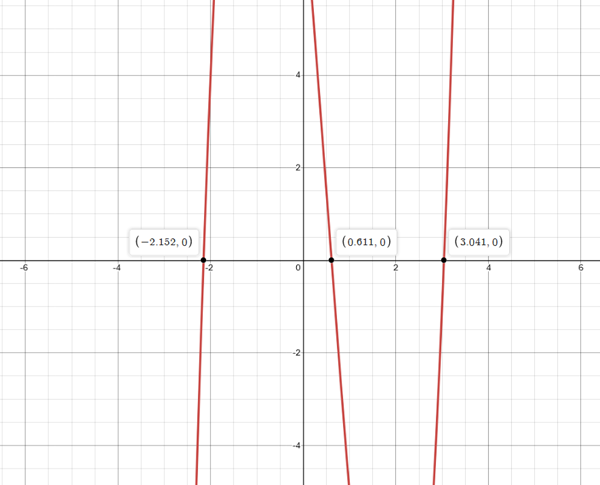
Concept explainers
To verify the upper and lower bounds using synthetic division and to determine the real zeros of the function
Upper bound:
Lower bound:
Answer to Problem 74E
Explanation of Solution
Given:
Function:
Upper bound:
Lower bound:
Calculation:
1. Verifying upper bound:
Using synthetic division,
Here, the last row values are positive values or zeros.
Hence, the upper bound of given function is x = 4.
2. Verifying lower bound:
Using synthetic division,
Here, the last row values are alternatively positive and negative.
Hence, the lower bound of given function is x = -3.
3. Calculation of real zeros:
Here, the zeros are calculated using graphical method.
Calculation for graph:
Consider
| Values of x | Values of f (x) |
| 0 | 3 |
| 1 | -3 |
| -1 | 19 |
| 2 | 13 |
| -2 | 51 |
By taking different values of x, the graph can be plotted.
Graph:

Interpretation:
By observing graph, it is clear that the curve of the function meets x-axis at
Hence, the zeros of the function are
Conclusion:
Therefore, the zeros of given polynomial function are
Chapter 2 Solutions
Precalculus with Limits: A Graphing Approach
 Calculus: Early TranscendentalsCalculusISBN:9781285741550Author:James StewartPublisher:Cengage Learning
Calculus: Early TranscendentalsCalculusISBN:9781285741550Author:James StewartPublisher:Cengage Learning Thomas' Calculus (14th Edition)CalculusISBN:9780134438986Author:Joel R. Hass, Christopher E. Heil, Maurice D. WeirPublisher:PEARSON
Thomas' Calculus (14th Edition)CalculusISBN:9780134438986Author:Joel R. Hass, Christopher E. Heil, Maurice D. WeirPublisher:PEARSON Calculus: Early Transcendentals (3rd Edition)CalculusISBN:9780134763644Author:William L. Briggs, Lyle Cochran, Bernard Gillett, Eric SchulzPublisher:PEARSON
Calculus: Early Transcendentals (3rd Edition)CalculusISBN:9780134763644Author:William L. Briggs, Lyle Cochran, Bernard Gillett, Eric SchulzPublisher:PEARSON Calculus: Early TranscendentalsCalculusISBN:9781319050740Author:Jon Rogawski, Colin Adams, Robert FranzosaPublisher:W. H. Freeman
Calculus: Early TranscendentalsCalculusISBN:9781319050740Author:Jon Rogawski, Colin Adams, Robert FranzosaPublisher:W. H. Freeman
 Calculus: Early Transcendental FunctionsCalculusISBN:9781337552516Author:Ron Larson, Bruce H. EdwardsPublisher:Cengage Learning
Calculus: Early Transcendental FunctionsCalculusISBN:9781337552516Author:Ron Larson, Bruce H. EdwardsPublisher:Cengage Learning





